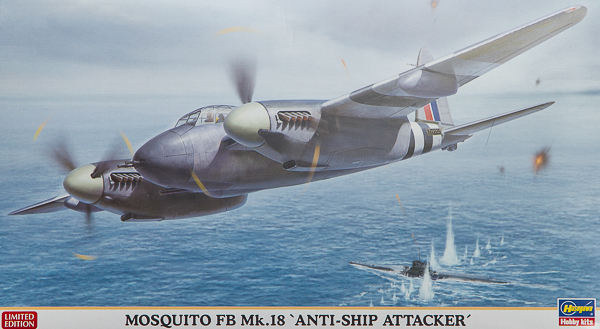
Hasegawa 1/72 Mosquito FB Mk 18 "Anti-Ship Attacker"
By Chris Banyai-Riepl
Overview
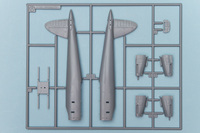 Trying to understand Mosquito variants can be quite challenging, as the airframe was well suited to modification and upgrading. One of the more unique modifications was the Mosquito Mk XVIII, or the "Tsetse" Mosquito. This evolution of the FB Mk VI Mosquito replaced the four 20mm cannons with the Molins 6-pounder Class M 57mm anti-tank cannon, with a 25-round capacity. The nose-mounted .0303 machine guns were retained (sometimes only two, sometimes all four) and were used mainly for sighting the 57mm cannon. Additional armor plating was also added to protect the engines and crew. Eighteen FB XVIII Mosquitos were built, and a further 27 were converted from FB VI Mosquitos. The Molins-armed Mosquitos quickly proved their worth in combat, with surface ships, U-boats, and even aircraft falling to the 57mm.
Trying to understand Mosquito variants can be quite challenging, as the airframe was well suited to modification and upgrading. One of the more unique modifications was the Mosquito Mk XVIII, or the "Tsetse" Mosquito. This evolution of the FB Mk VI Mosquito replaced the four 20mm cannons with the Molins 6-pounder Class M 57mm anti-tank cannon, with a 25-round capacity. The nose-mounted .0303 machine guns were retained (sometimes only two, sometimes all four) and were used mainly for sighting the 57mm cannon. Additional armor plating was also added to protect the engines and crew. Eighteen FB XVIII Mosquitos were built, and a further 27 were converted from FB VI Mosquitos. The Molins-armed Mosquitos quickly proved their worth in combat, with surface ships, U-boats, and even aircraft falling to the 57mm.
The Kit
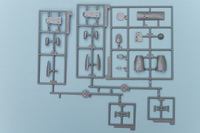 The Hasegawa Mosquito was the first new-tool 1/72 Mosquito after the Airfix kit from the 1970s, and as such it was very welcome. Well detailed and produced in a multitude of variants, the Hasegawa Mosquito has been re-released many times. This is the first time, though, it has shown up as the FB.18 variant, as it required some extra bits that were not found on other Mosquito variants. Hasegawa has decided to take care of these different parts with a blend of resin and metal, in addition to the standard plastic parts. The decal sheet provides markings for two aircraft.
The Hasegawa Mosquito was the first new-tool 1/72 Mosquito after the Airfix kit from the 1970s, and as such it was very welcome. Well detailed and produced in a multitude of variants, the Hasegawa Mosquito has been re-released many times. This is the first time, though, it has shown up as the FB.18 variant, as it required some extra bits that were not found on other Mosquito variants. Hasegawa has decided to take care of these different parts with a blend of resin and metal, in addition to the standard plastic parts. The decal sheet provides markings for two aircraft.
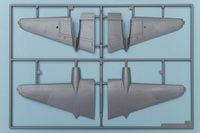 As typical of Hasegawa kits from the 1990s, this kit comes with a fairly simple interior, with some smaller parts but no raised detailing. The cockpit assembly starts with the cockpit floor, which gets separate rudder pedals, a control column, a two-part seat, an instrument panel with separate gunsight, and a forward bulkhead. This assembly gets sandwiched between the two nose halves, while the rest of the interior is part of the wing spar/bomb bay assembly. This part gets a spar piece, a rear cockpit piece, a small seat, and a rear bomb bay bulkhead. This assembly then gets sandwiched between the rear fuselage halves.
As typical of Hasegawa kits from the 1990s, this kit comes with a fairly simple interior, with some smaller parts but no raised detailing. The cockpit assembly starts with the cockpit floor, which gets separate rudder pedals, a control column, a two-part seat, an instrument panel with separate gunsight, and a forward bulkhead. This assembly gets sandwiched between the two nose halves, while the rest of the interior is part of the wing spar/bomb bay assembly. This part gets a spar piece, a rear cockpit piece, a small seat, and a rear bomb bay bulkhead. This assembly then gets sandwiched between the rear fuselage halves.
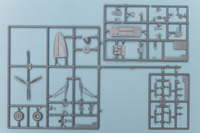 Once the nose is attached to the fuselage, the rest of the assembly is pretty straightforward. The wings are split into upper and lower halves, with separate engine nacelles and wheel wells. The engine nacelles are split into right and left halves, while the wheel wells are a simple insert. The propellers feature a separate hub, propeller blades, and rear plate. The landing gear is an interesting assembly, with the wheel split into halves with a separate hub piece. The strut is separate right and left halves, with a separate mud flap. The tailplanes finish up the major assembly of the kit.
Once the nose is attached to the fuselage, the rest of the assembly is pretty straightforward. The wings are split into upper and lower halves, with separate engine nacelles and wheel wells. The engine nacelles are split into right and left halves, while the wheel wells are a simple insert. The propellers feature a separate hub, propeller blades, and rear plate. The landing gear is an interesting assembly, with the wheel split into halves with a separate hub piece. The strut is separate right and left halves, with a separate mud flap. The tailplanes finish up the major assembly of the kit.
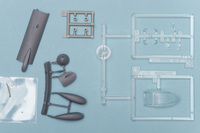 Moving on to the specific parts for the FB.18, as noted these are mainly resin bits. The bomb bay cover is one piece, with a bulge on the forward edge. Also in resin is the lower nose piece, which has the slot for brass 57mm cannon barrel. While on the subject of guns, the nose tip is resin and has the spots for the other nose guns. Finally, there are two slipper tanks in resin for the outer wings. Pay attention to the instructions and check photo references to make sure these are placed in the right spot.
Moving on to the specific parts for the FB.18, as noted these are mainly resin bits. The bomb bay cover is one piece, with a bulge on the forward edge. Also in resin is the lower nose piece, which has the slot for brass 57mm cannon barrel. While on the subject of guns, the nose tip is resin and has the spots for the other nose guns. Finally, there are two slipper tanks in resin for the outer wings. Pay attention to the instructions and check photo references to make sure these are placed in the right spot.
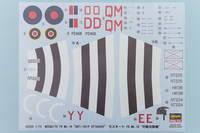 The decal options provide markings for two RAF Mosquitos, both finished in the standard camouflage scheme of green and gray. The first option is from 248 Squadron and features invasion stripes on the fuselage and wings and has a single letter "O" fuselage code. The second option is from 254 Squadron and does not have invasion stripes. This aircraft is coded QM-D. The decals are nicely printed and include optional markings for two additional aircraft, although the instructions do not provide any information as to their camouflage or squadron.
The decal options provide markings for two RAF Mosquitos, both finished in the standard camouflage scheme of green and gray. The first option is from 248 Squadron and features invasion stripes on the fuselage and wings and has a single letter "O" fuselage code. The second option is from 254 Squadron and does not have invasion stripes. This aircraft is coded QM-D. The decals are nicely printed and include optional markings for two additional aircraft, although the instructions do not provide any information as to their camouflage or squadron.
Conclusion
This is a nice re-release of the classic Hasegawa Mosquito, and the addition of the new resin detail bits to convert it to the FB.18 variant are very welcome indeed. This should build up easily and will make for an interesting Mosquito on the shelf. My thanks to Hasegawa USA for the review sample.
